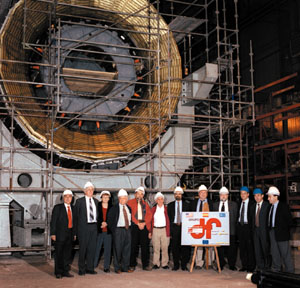
Research institutes all over the world are busy providing components for the experiments at CERN’s Large Hadron Collider.
The hadronic calorimeter for the Compact Muon Solenoid (CMS) experiment reached an important milestone on 27 October 2000 when the first half of its barrel structure was test assembled at the Felguera Construcciones Mecánica SA plant in the Asturias region of Spain. The structure has since been dismantled and transported to CERN, where the sensitive elements – scintillator tiles with optical-fibre read-out – will be installed over the coming year.
CMS has adopted a conventional scintillator/absorber sandwich architecture for its hadronic calorimeter. However, because the device will be installed inside the experiment’s powerful solenoid magnet, it is subject to unconventional constraints. The absorber material – brass – has been chosen because it is non-magnetic, cheap, easy to machine and sufficiently dense for the job. The brass has been supplied by companies in both Bulgaria and the UK.
Read-out is via optical fibres that are coupled to hybrid photodiodes that are capable of functioning within the CMS magnet. Design and construction of the CMS barrel hadronic calorimeter are the responsibility of Fermilab in the US, which awarded the contract for the building the structure to Felguera.
Full assembly of the first half of the barrel structure allowed the experiment to verify that the exacting tolerances that are required between the 25 tonne wedges to eliminate gaps had been achieved. This ensures that the calorimeter has full azimuthal coverage without any cracks.
The next step is the installation of the scintillator elements at CERN. Production of these elements is more than 50% complete, and delivery from Fermilab to CERN is well advanced. Installation of the scintillator into the first half barrel should be completed by the autumn, with the second half following by the end of 2002. The integration and testing of the detector will take place in 2003.





